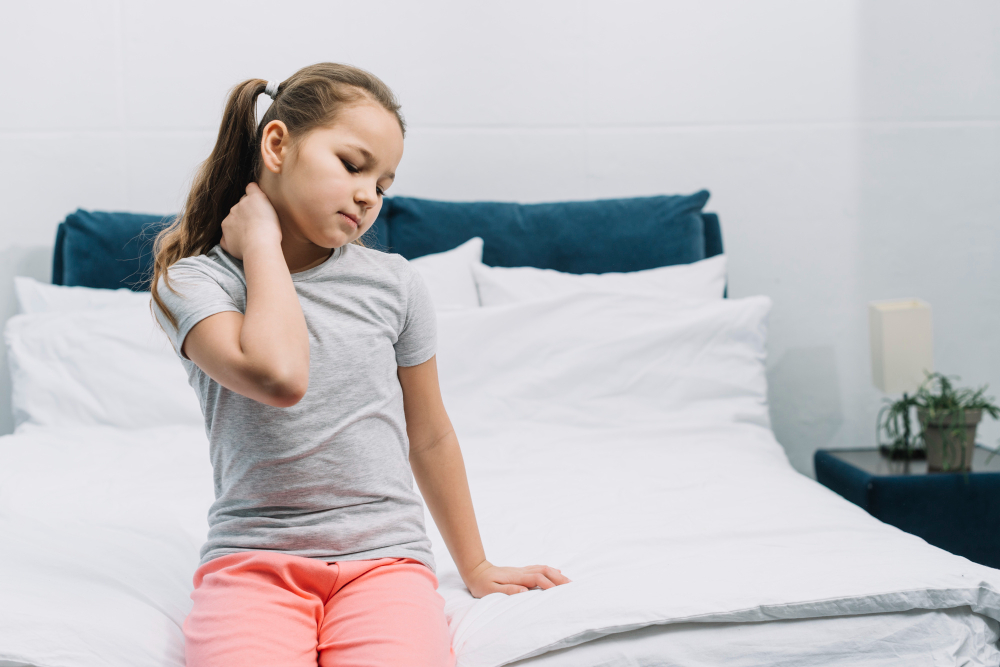health
A study showed that approximately 30% of children and adolescents experience muscle, bone, or ligament pain
The panorama of musculoskeletal pain was revealed through research involving 2,688 students from Ceara and São Paulo. The results point to the back and legs as the main body parts affected
health
A study showed that approximately 30% of children and adolescents experience muscle, bone, or ligament pain
The panorama of musculoskeletal pain was revealed through research involving 2,688 students from Ceara and São Paulo. The results point to the back and legs as the main body parts affected

About 20% of the young people who participated in the survey complained of neck pain (Photo: Freebeck*)
Giulia Moioli | FAPESP Agency – About 27% of Brazilian children and adolescents suffer from pain without a specific cause in the bones, ligaments and muscles – so-called musculoskeletal pain – according to a study. published Recently in Brazilian Journal of Physical Therapy. In addition to contributing to demystifying the problem, which is often underestimated by parents and health professionals, according to the authors, knowing its magnitude allows better planning of spending on chronic pain in adults, which is The main reason Disability around the world.
In Brazil, the Ministry of Health estimates that more than 35% of Brazilians over the age of 50 suffer from chronic pain. In fact, the law was approved last year 14,705/23Which sets guidelines for the care of these patients through the Unified Health System (SUS). Although most of the risk factors for this condition are little known, one of the best is a history of previous pain – with reports in the scientific literature of its onset in adolescence.
“There are still few studies around the world on the prevalence of musculoskeletal pain among young people, with uncertain data ranging from 4% to 40%, because they do not use standardized concepts,” he says. T parma yamatoa research associate at the Universidad de São Paulo (UNICED) and the University of Sydney (Australia) who coordinated the investigation.
“In Brazil, this number appears to range from 20% to 45% according to previous studies, however, the vast majority of studies investigated specific musculoskeletal conditions and did not take into account the impact of pain on the daily activities of children and adolescents and were conducted.” In small towns.”
In the research coordinated by Yamato, which received funding from FAPESP through three projects (17/17484-1, 19/10330-4 that it 19/12049-0), 2,688 children and adolescents with an average age of 12 years, from 28 public and private schools in the states of Ceará (city of Fortaleza) and São Paulo (cities of Itú, Salto, São Sebastião, São Paulo), responded to a questionnaire containing questions about the occurrence of body pain that can cause Affect your daily life, such as missing school and/or preventing you from doing daily activities and/or sports.
Among these youth, 728 (27.1%) reported that they had experienced disabling musculoskeletal pain in the previous 30 days. The back was the most frequently mentioned body part, by 51.8% of participants, followed by the legs (41.9%) and the neck (20.7%).
“At the same time as they raise alarm about this health condition in children and adolescents, which currently has no specific treatment protocol in the health system, these numbers actually encourage us to look to the future: we will need attention from younger populations as well if we are to reduce chronic pain in adults.” “
The work also brought back other important data on the characteristics of the children who felt the most pain: they were older (late adolescence), had a worse relationship with their families, had more negative psychosomatic symptoms, and had a lower quality of life (also assessed). (By questionnaires) and they seem to spend more time watching TV and playing video games. “But it is worth noting that we did not observe a causal relationship in this study,” Yamato says.
The growing pains myth
In addition to the children's participation in the study, their parents also filled out a questionnaire about their child's health condition and their perception of this type of pain.
“Literature shows that parents tend to underestimate children's complaints, perhaps because they do not have a clear understanding of what childhood pain is, and we confirmed that this happens in 17% of cases,” says Yamato.
One factor that can explain this situation and also camouflage, in a certain way, musculoskeletal pain is the belief in common “growing pains”, which refer to possible discomfort in children's limbs, especially the lower limbs. “We grew up with this concept, but today, in the scientific literature, there is no study that can prove that growth actually causes pain.”
According to the researcher, if your child reports pain, it is important to realize that it can have effects, but there are also ways to treat it – most measures are based on physical activity. “There is no reason to be overly concerned, but it is important to know the condition, validate the symptoms and perhaps seek help for those whose lives have been affected by the condition. Always remember that this is a common problem.
A follow-up study conducted by the same group, the results of which are expected to be published soon, followed these children for a year and a half to understand the duration of pain and also its financial impact on the health care system.
Article Prevalence of disabling musculoskeletal pain in children and adolescents in Brazil: a cross-sectional study It can be read on: www.sciencedirect.com/science/article/abs/pii/S1413355524000042.

“Wannabe internet buff. Future teen idol. Hardcore zombie guru. Gamer. Avid creator. Entrepreneur. Bacon ninja.”
